What Are Igneous Rocks?
Igneous rocks are formed from molten rock material1. They are one of the three main classes of rocks, alongside sedimentary and metamorphic rocks.
Molten rock beneath the Earth’s surface is called magma. When magma reaches the surface, it is known as lava. Igneous rocks that solidify below the surface are called plutonic (or intrusive) rocks, while those that solidify at or near the surface are called volcanic rocks.
Explosive volcanic eruptions produce fragmental volcanic rocks known as pyroclastic rocks. In contrast, non-explosive or less explosive eruptions result in lava flows that solidify into lava rocks.
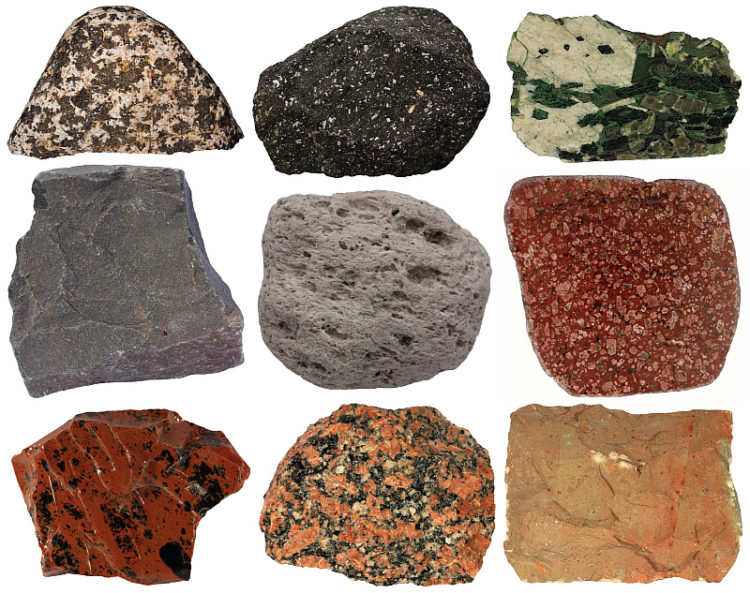
Classification of Igneous Rocks
Igneous rocks are primarily classified based on their composition—either mineralogical or chemical. However, there are exceptions where classification is based on texture rather than composition.
Plutonic Rocks
Plutonic rocks are coarse-grained igneous rocks that crystallized slowly within the Earth’s crust. These rocks are typically classified according to their mineral composition. The most important minerals used for classification include quartz, feldspars, pyroxene, olivine, hornblende, and feldspathoids.
The classification of most plutonic rocks relies on the QAPF diagram, which considers the proportions of quartz (Q), alkali feldspar (A), plagioclase feldspar (P), and feldspathoids (F). Mafic and ultramafic plutonic rocks are classified using separate diagrams because they typically lack quartz and feldspars—the key components of the QAPF system.
A notable exception is pegmatite. Although most pegmatites have a granitic composition, their defining feature is texture—pegmatites are extremely coarse-grained plutonic rocks, often with crystal sizes exceeding several centimeters.
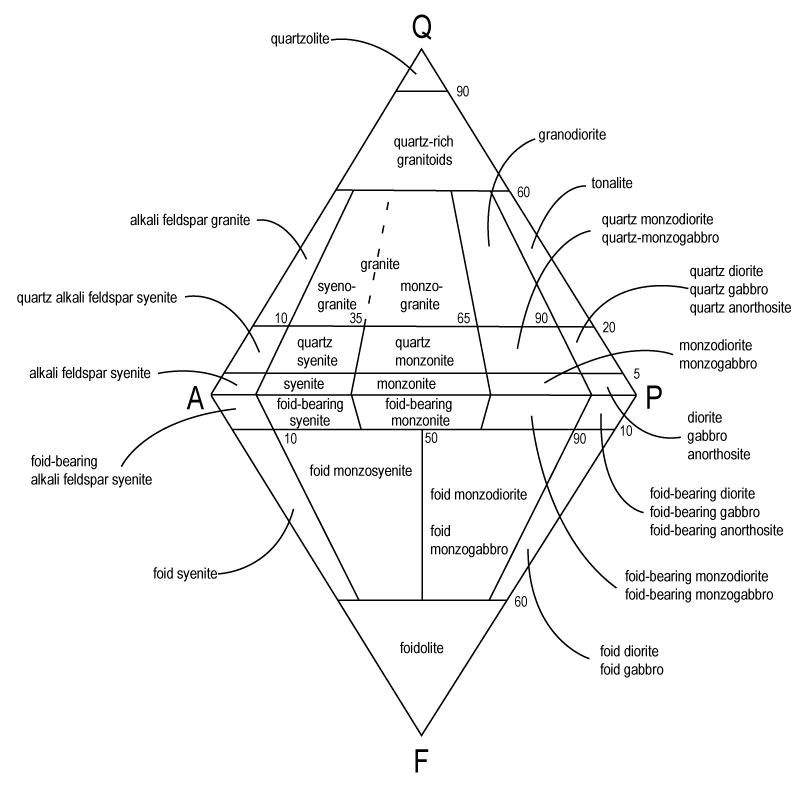
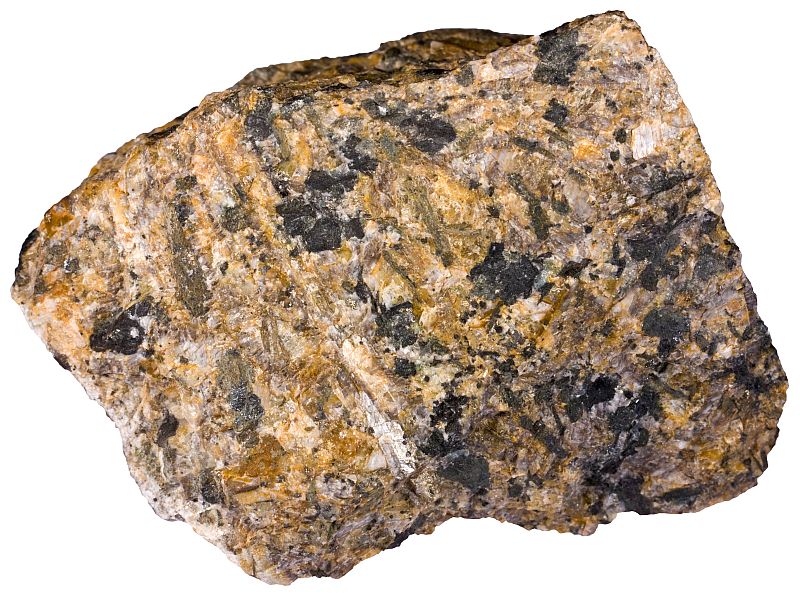
Volcanic Lava Rocks
Volcanic rocks are typically fine-grained or glassy due to rapid cooling. As a result, they are classified based on chemical composition rather than mineralogy, which is difficult to determine under the microscope.
Volcanic rocks such as basalt, andesite, and phonolite are classified using the TAS diagram (Total Alkali-Silica diagram), which plots the relative proportions of alkalis and silica. These boundaries are strictly defined and provide a standardized system for naming volcanic rocks.
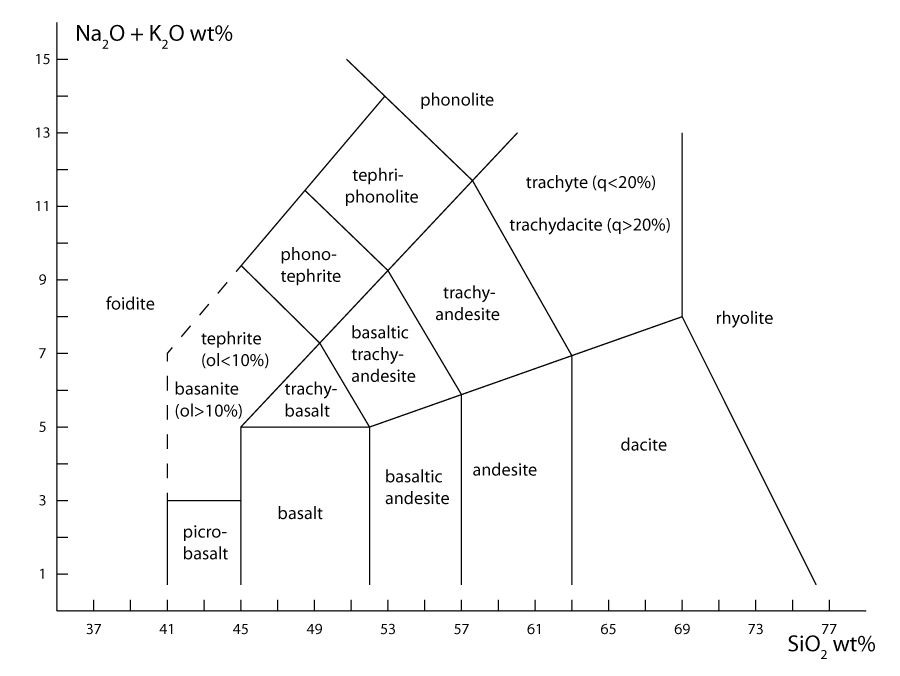
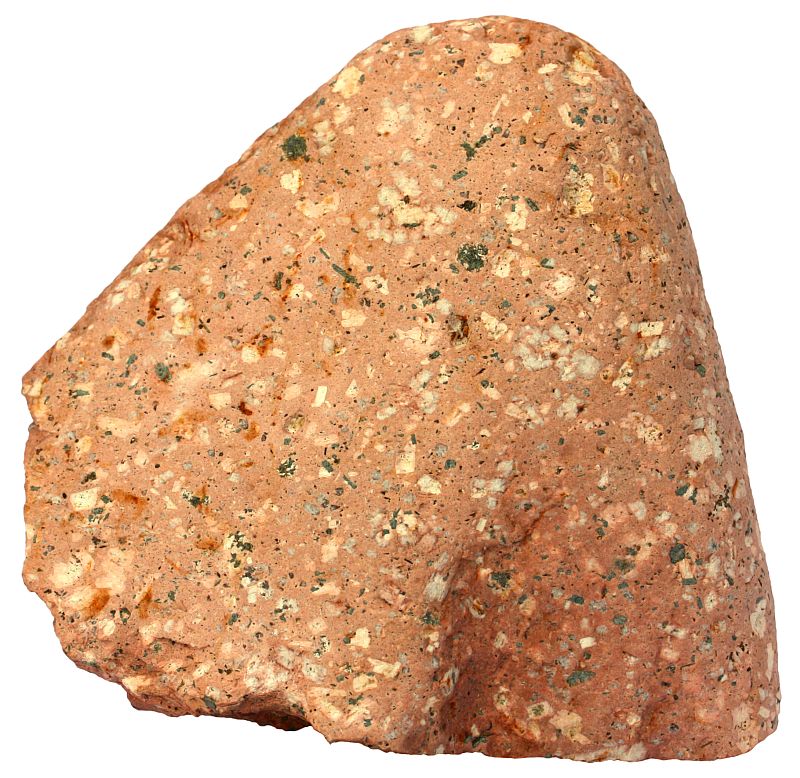
Rhyolite is a volcanic rock with granitic composition. Volcanic rocks are fine-grained (individual crystals are not visible to the naked eye), but they often contain larger crystals (phenocrysts) embedded in the fine-grained groundmass. These phenocrysts formed before the magma was expelled from the volcanic vent. Width of sample: 8 cm.
Pyroclastic Rocks
Pyroclastic rocks form during explosive volcanic eruptions when magma is violently fragmented and ejected into the atmosphere. They are composed of volcanic ash, lapilli, bombs, and blocks.
These rocks are classified based on grain size and the relative proportions of different components. For example, a tuff is dominated by ash-sized particles, while an agglomerate consists mainly of larger clasts such as bombs or blocks. Pyroclastic rocks are technically distinct from both lava rocks and sedimentary deposits, though they may resemble either under certain conditions.
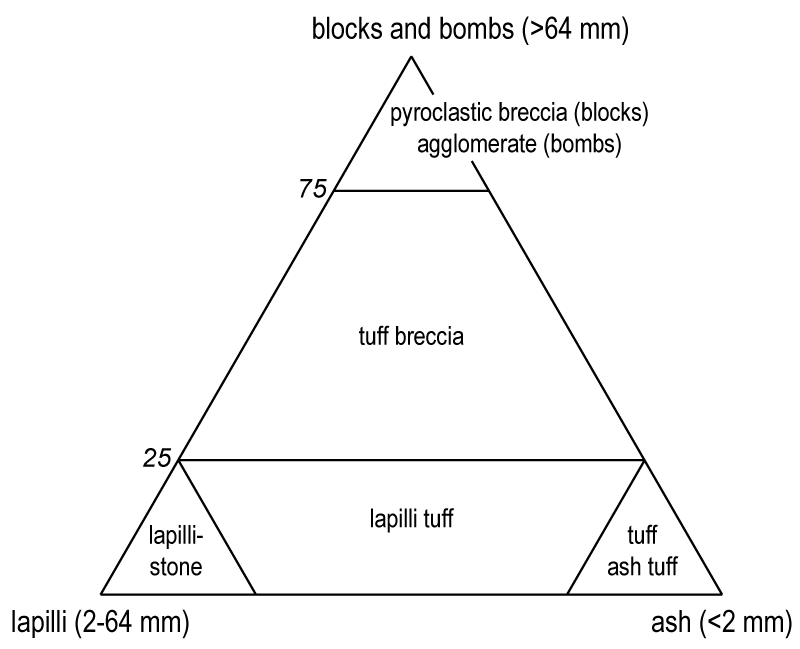
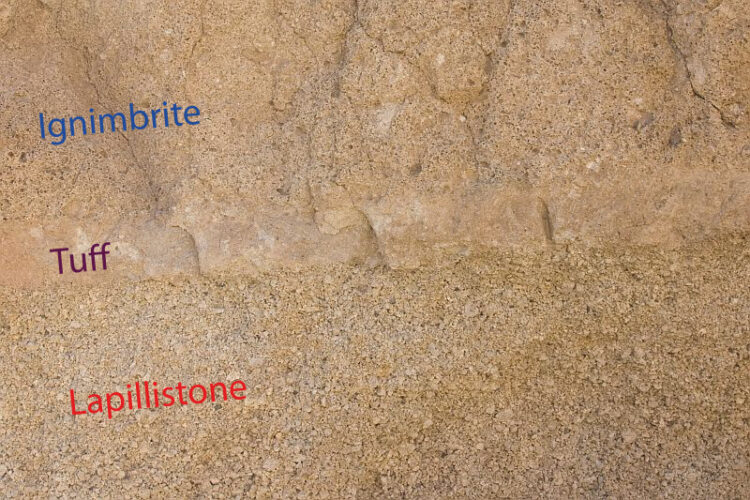
Rocks that do not fit neatly into the system
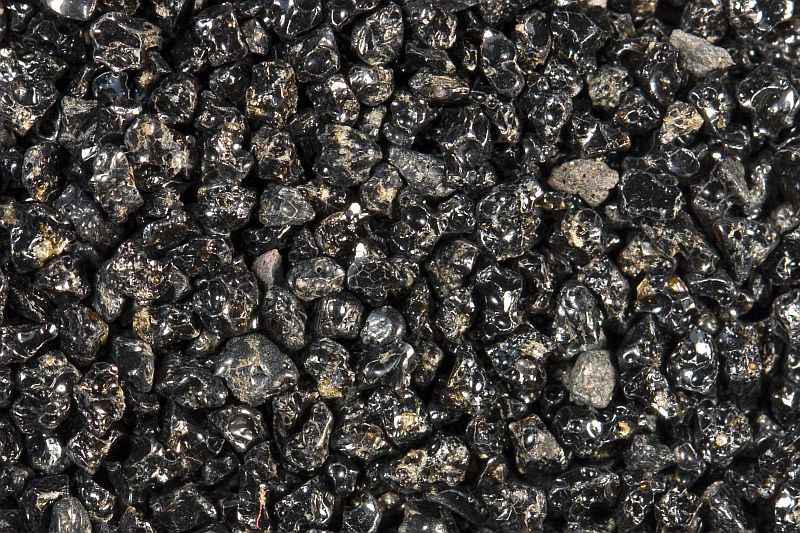
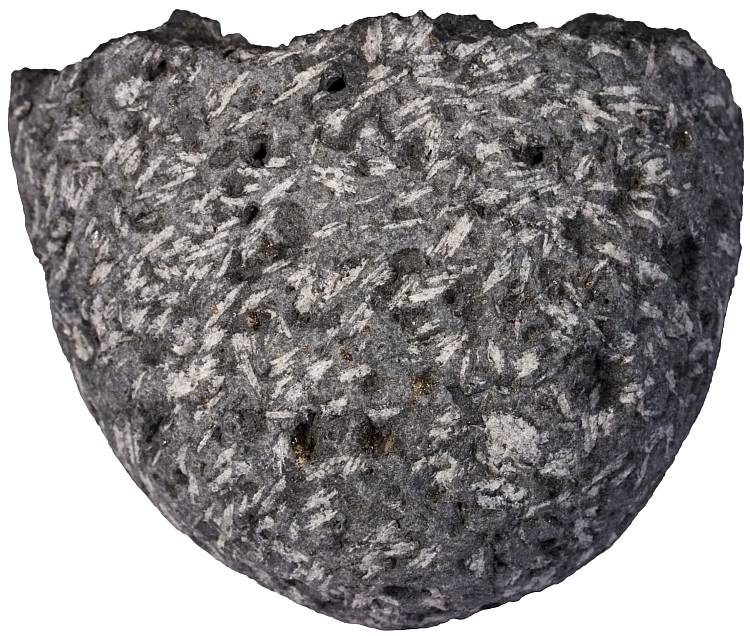
Compositionally, it is identical to basalt and gabbro, but texturally it falls somewhere between the two. These rocks usually form in the crust at relatively shallow depths, near the surface. Diabase and similar rocks are sometimes referred to as hypabyssal, though that term is now somewhat outdated. The white crystals are plagioclase phenocrysts. Sample from La Palma, Canary Islands. Width of sample: 5 cm.
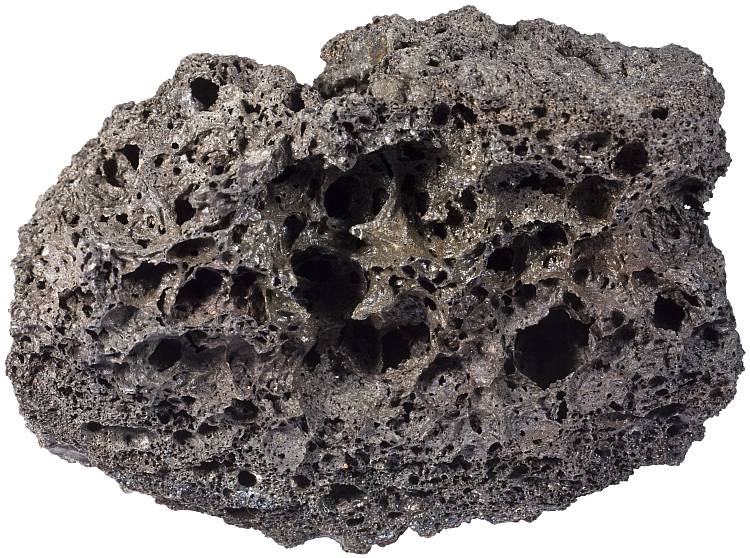
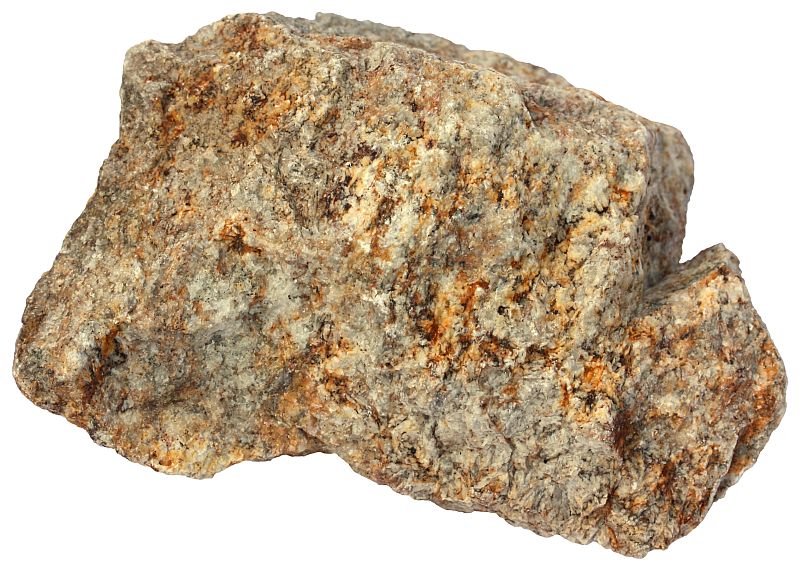
Composition of igneous rocks
The range of chemical compositions found in igneous rocks reflects the average bulk composition of the Earth’s crust. The most important chemical elements are oxygen and silicon. Common igneous rocks contain between 40% and 77% silica (SiO2). Other important oxides include alumina (Al2O3), magnesia (MgO), lime (CaO), soda (Na2O), and potash (K2O).
Average chemical composition of granitic and basaltic rocks based on 2,485 and 3,594 analyzed rock samples, respectively3:
| Rock type | SiO2 | TiO2 | Al2O3 | Fe2O3 | FeO | MnO | MgO | CaO | Na2O | K2O | P2O5 |
| Granite | 71.84 | 0.31 | 14.43 | 1.22 | 1.65 | 0.05 | 0.72 | 1.85 | 3.71 | 4.10 | 0.12 |
| Basalt | 49.97 | 1.87 | 15.99 | 3.85 | 7.24 | 0.20 | 6.84 | 9.62 | 2.96 | 1.12 | 0.35 |
The numbers given in the table above represent weight percentages. Granite contains significantly more silicon and potassium than basalt. Basalt, on the other hand, is richer in iron, titanium, and magnesium.
Real igneous rocks do not generally contain these chemical compounds (potash, lime, etc.) as discrete substances. This is simply a traditional way of expressing the chemical composition of igneous rocks—one that has persisted despite lacking much logical justification today. In reality, igneous rocks are composed primarily of minerals. Silica, for example, does occur as the mineral quartz, but there is no such mineral as “magnesia” or “potash.” Common magnesium-bearing minerals in mafic igneous rocks include olivine and pyroxenes. The most important potassium-bearing minerals are K-feldspar and micas.
The chemical composition of a rock determines its mineralogical composition because chemical elements are the building blocks of minerals. Granite is rich in quartz and K-feldspar because it contains high amounts of silicon and potassium. Basalt, by contrast, contains large amounts of iron and magnesium, which are incorporated into pyroxenes and olivine. Basalt also has much more calcium than granite, which is why the dominant feldspar in basalt is Ca-bearing plagioclase rather than K-feldspar.
Igneous rocks also contain a number of less common or volumetrically minor minerals that utilize trace chemical components. Common accessory minerals in igneous rocks include apatite, titanite, magnetite, ilmenite, zircon, tourmaline, beryl, epidote, rutile, allanite, garnet, chromite, spinel, monazite, and others4.
Common igneous minerals
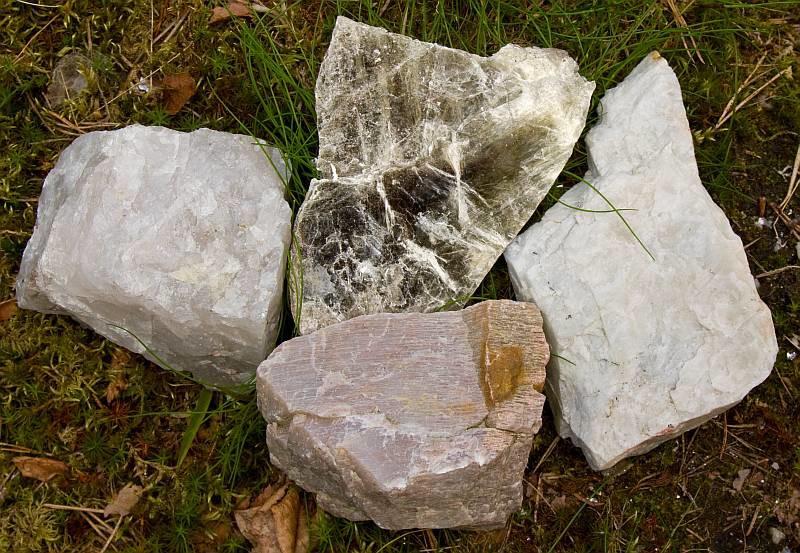
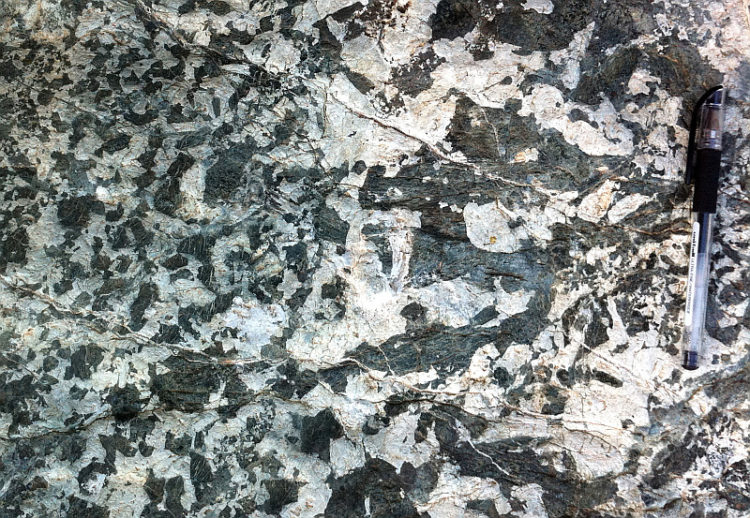
Here is an example of pegmatitic gabbro from Cyprus, composed of light-colored plagioclase and dark-colored pyroxene (augite). Both plagioclase and pyroxenes are widespread minerals in the Earth’s crust and especially common in basaltic rocks.
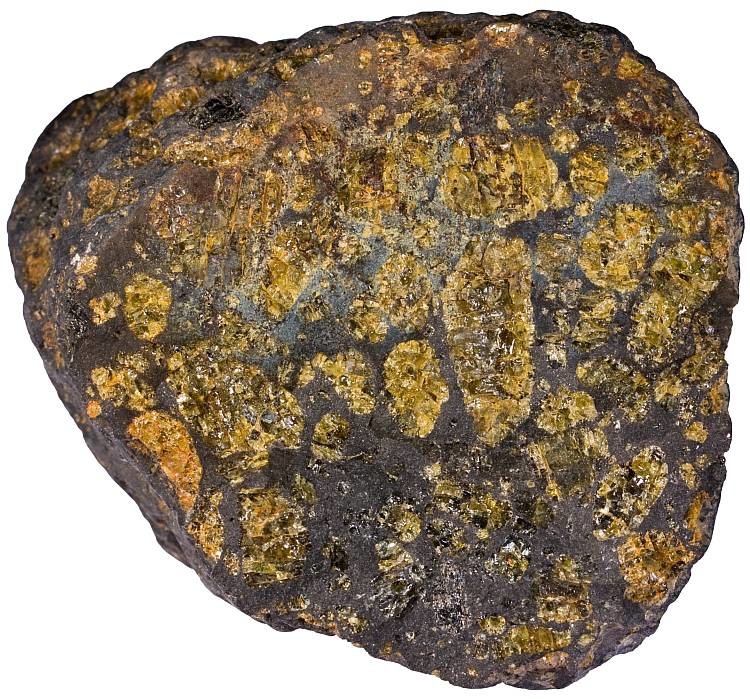
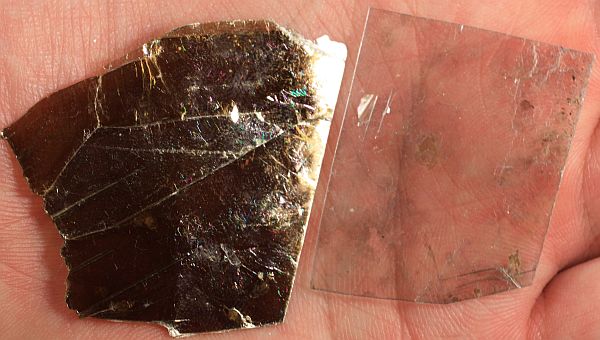
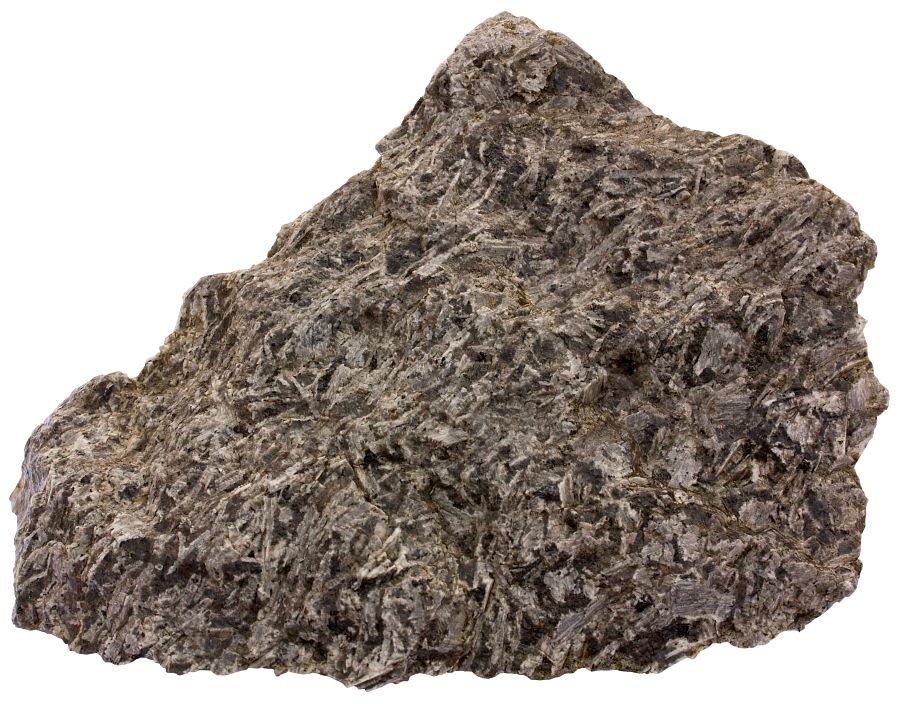
The most important feldspathoid mineral is nepheline. The rock sample shown above is nepheline syenite (foyaite). Gray areas represent alkali feldspar, while the darker gray parts are nepheline. Width of sample: 16 cm.
Igneous rocks in the field
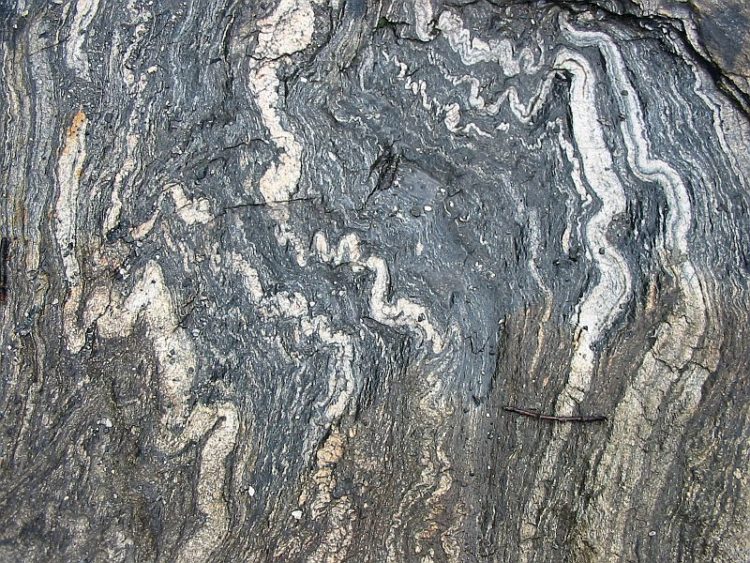
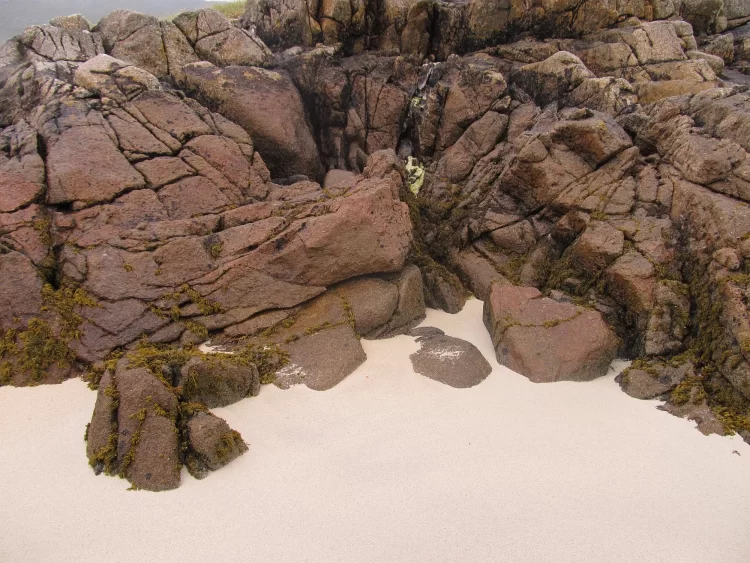
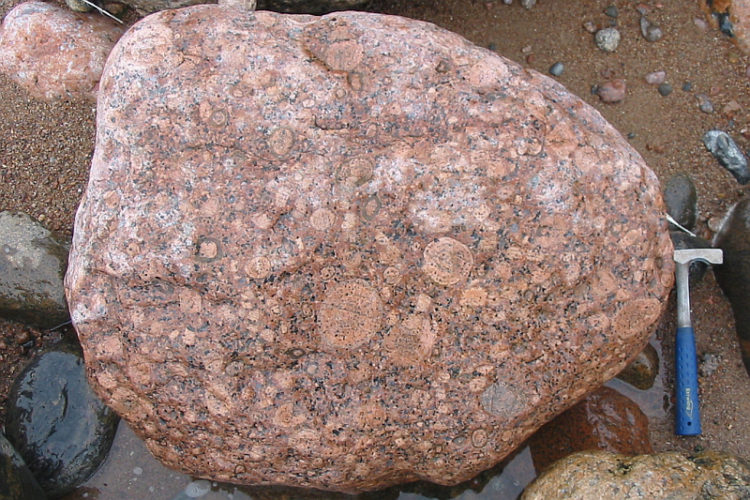
This boulder originates from the Vyborg batholith, which is largely composed of rapakivi granite—a distinctive variety of granite characterized by large, rounded alkali feldspar crystals.
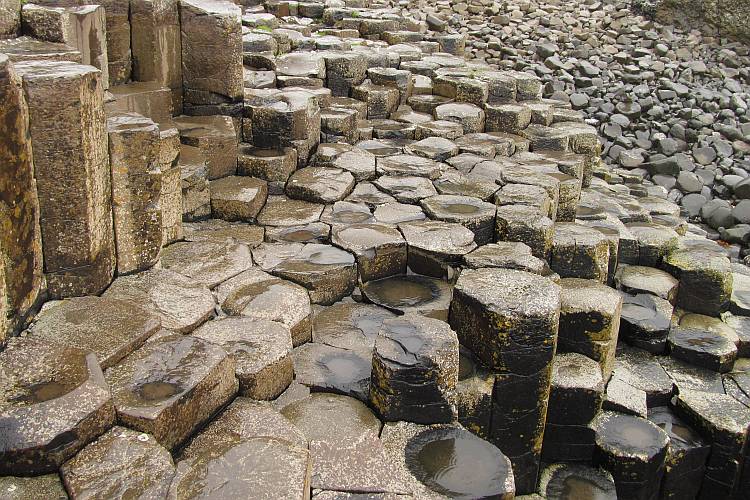
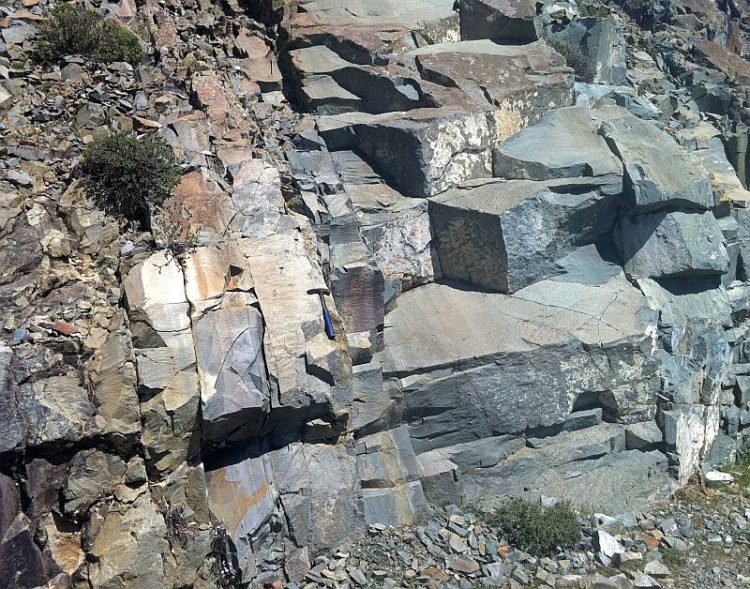
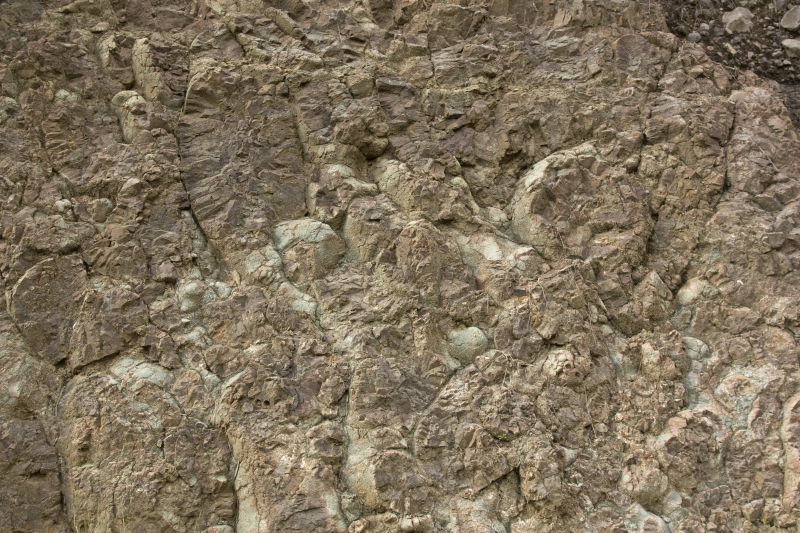
When lava erupts beneath water, its surface rapidly quenches, forming a hard crust while the interior remains molten and expands into a pillow-like shape. Modern seafloors are covered in such structures. This pillow basalt outcrop in La Palma formed when the island was still a submerged seamount. It is now visible due to uplift and erosion within the Caldera de Taburiente.
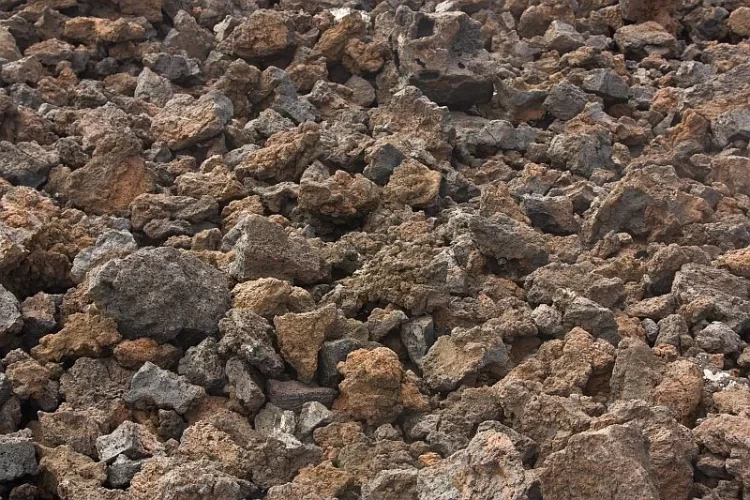
This photo shows the edge of a lava flow in La Palma that resembles a massive pile of rocks.
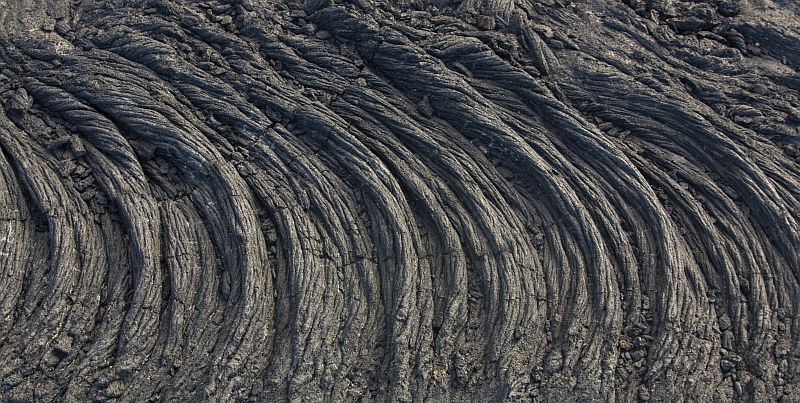
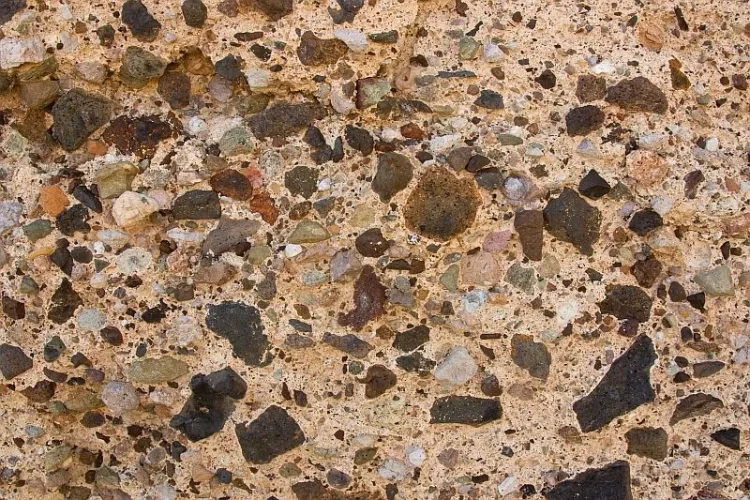
This rock deposit in Tenerife was laid down by a fast-moving, fiery cloud of ash, gas, and rock fragments that surged down a volcano’s slopes, incinerating everything in its path. Width of view: 0.8 meters.

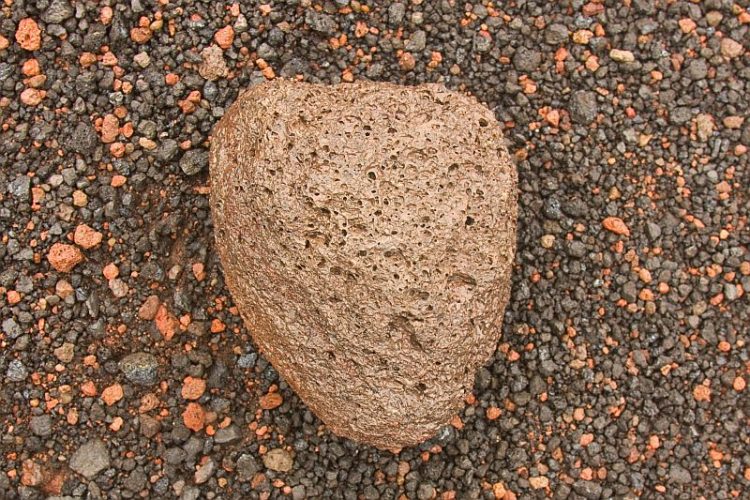
Mineral resources associated with igneous rocks
Igneous rocks are important sources of many metals and diamonds, and they also make excellent ornamental and building stones.
Felsic, coarse-grained pegmatites often contain minerals that are rich in relatively rare chemical elements. Elements such as tin, fluorine, tungsten, zinc, thorium, lithium, and beryllium may be extracted from felsic pegmatites. Ultramafic igneous rocks, on the other hand, can be rich in chromium, titanium, iron, vanadium, and nickel5.
Magmatic hydrothermal fluids can transport significant amounts of metals such as copper and gold away from their source rocks and deposit them in other geological environments. For example, gold in quartz veins originates from magma. It is typically associated with chlorine, which enables gold to dissolve in water and be carried away. When magmatic fluids react with granitic rocks, they may produce greisens, which often contain appreciable amounts of elements like tin and fluorine. Similarly, reactions between magmatic fluids and carbonate rocks result in the formation of diverse calc-silicate minerals. These rocks are known as skarns, and they frequently contain valuable metal-bearing minerals as well.
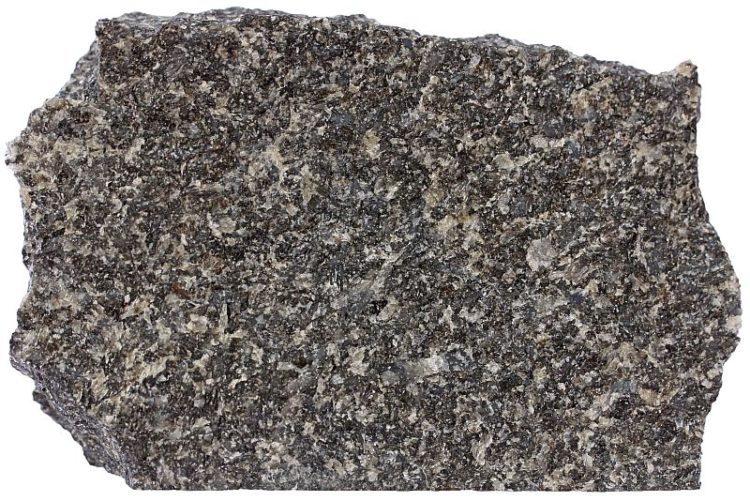
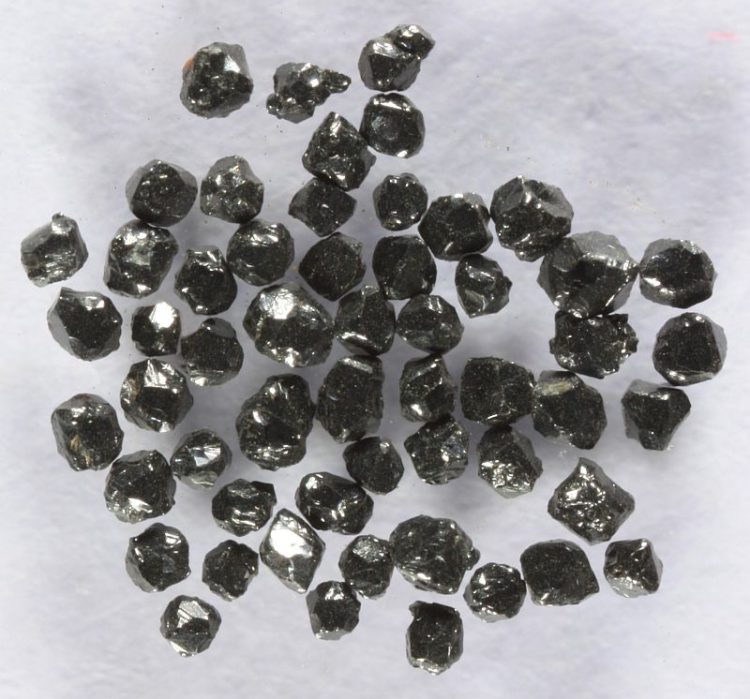
The concentrate is from the Rustenburg mine in the Western Bushveld, South Africa. Width of view: 5 mm.
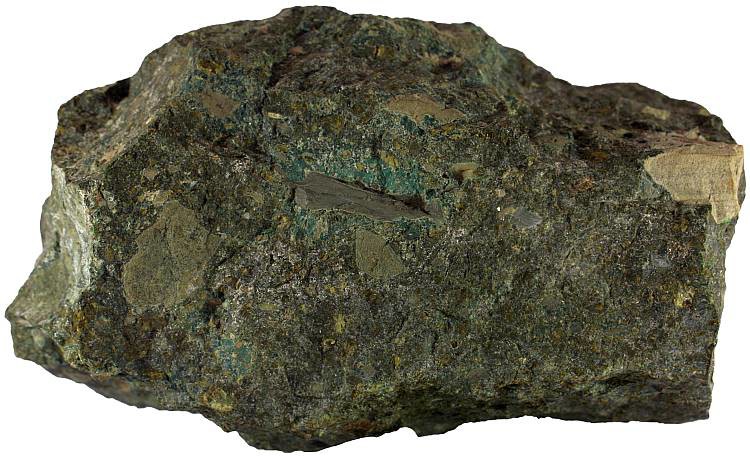
It contains diamonds and fills pipe-like structures (diatremes) in the crust that formed during explosive, gas-rich eruptions. Although small tuff rings sometimes form on the surface, most kimberlitic magma never erupts. Diamonds are typically mined from deep below the surface. This sample is from Kimberley (“blue ground”), South Africa. Width of sample: 11 cm.
Other Uses of Igneous Rocks
In addition to their economic importance as sources of metals and minerals, igneous rocks are widely used for various practical and aesthetic purposes. Their strength, durability, and resistance to weathering make many of them excellent materials for construction. Granite, for example, is a popular choice for countertops, flooring, building facades, and monuments. Its coarse-grained texture and attractive appearance also make it a favored decorative stone.
Basalt is another commonly used igneous rock. Its high density and compressive strength make it ideal for use as crushed stone in road construction and railway ballast. It is also used in the production of rock wool, a material used for thermal and acoustic insulation.
Obsidian, due to its glassy nature and sharp edges when fractured, was historically used to make tools and weapons. Even today, it is occasionally used in surgical scalpels due to its extremely fine cutting edge. In addition, polished igneous rocks are often used in jewelry, ornamental carvings, and interior design, demonstrating that their value goes far beyond geology and industry.
You may also like
References
1. Raymond, Loren A. (2007). Igneous rocks. In: McGraw Hill Encyclopedia of Science & Technology, 10th Edition. McGraw-Hill. Volume 9. 14-20.
2. Le Maitre, R. W. (2005). Igneous Rocks: A Classification and Glossary of Terms: Recommendations of the International Union of Geological Sciences Subcommission on the Systematics of Igneous Rocks, 2nd Edition. Cambridge University Press.
3. Best, Myron G. (2002). Igneous and Metamorphic Petrology, 2nd Edition. Wiley-Blackwell.
4. Nesse, William D. (2011). Introduction to Mineralogy, 2nd Edition. Oxford University Press.
5. Robb, L. (2005). Introduction to Ore-Forming Processes. Blackwell Science Ltd.


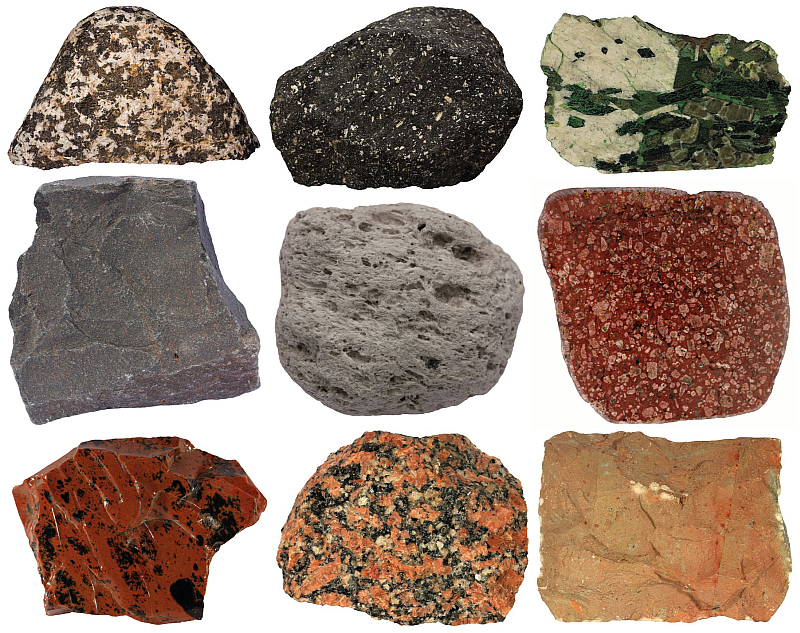
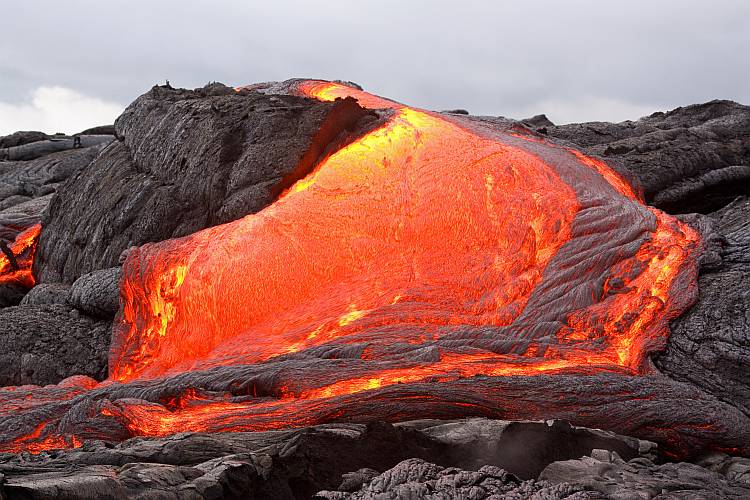
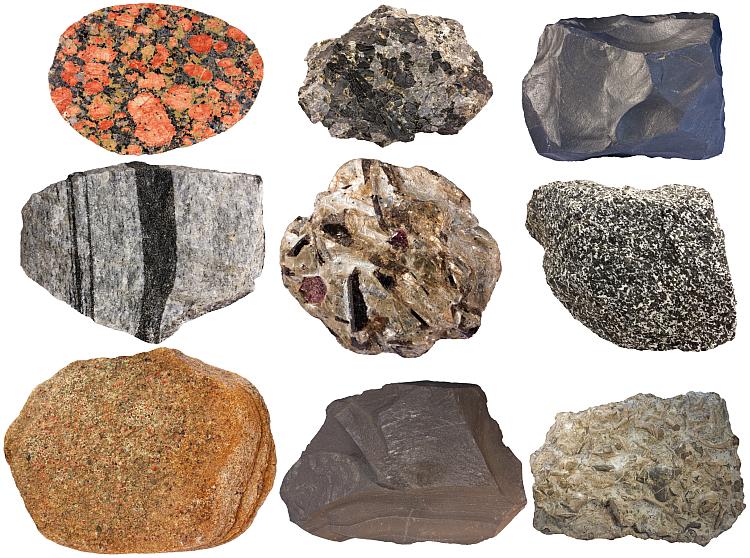
I would be very pleased to receive fotos or slides of igneous , sedimentary and metamorphism rocks……thanks much and hope success for you
This helped me a lot with my rock project for school and it has a lot of information in it thank u 🙂